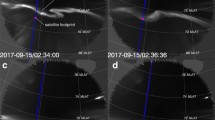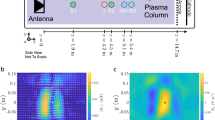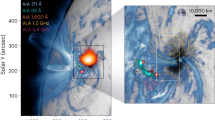Abstract
AURORAL displays are usually attributed to increased leakage of electrons from the outer radiation belt. The mechanism responsible for this increased leakage is not yet understood, but the leakage is known to occur following the arrival of corpuscular radiation from the Sun. The time delay between solar eruptions and the onset of auroral phenomena shows that any solar electrons involved must have energies below 100 eV. Because, on the other hand, auroral electrons typically have energies in the range of several tens of keV, an electron acceleration mechanism must exist, presumably within the radiation belt. The purpose of this communication is to point out similarities between auroral effects and laboratory observations of electron leakage from a magnetic mirror, accompanied by electron acceleration, and to suggest that the same basic mechanism may play a part in both cases.
This is a preview of subscription content, access via your institution
Access options
Subscribe to this journal
Receive 51 print issues and online access
$199.00 per year
only $3.90 per issue
Buy this article
- Purchase on Springer Link
- Instant access to full article PDF
Prices may be subject to local taxes which are calculated during checkout
Similar content being viewed by others
References
Hirsch, E. H., Brit. J. App. Phys., 15, 909 (1964).
Hirsch, E. H., Brit. J. App. Phys., 15, 1535 (1964).
Author information
Authors and Affiliations
Rights and permissions
About this article
Cite this article
HIRSCH, E. Auroral Effects and Excess Energy Electrons. Nature 209, 390–391 (1966). https://doi.org/10.1038/209390a0
Issue Date:
DOI: https://doi.org/10.1038/209390a0
Comments
By submitting a comment you agree to abide by our Terms and Community Guidelines. If you find something abusive or that does not comply with our terms or guidelines please flag it as inappropriate.



